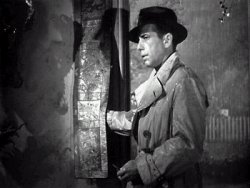Is It Really a Great Movie? Part Eighteen: The Big Sleep
by dan heaton
Using Roger Ebert's Great Movies book as a guide, this series of articles will focus on all films included on his list that previously have escaped my notice. Since all lists are subjective, I am not treating Ebert's choices as the essential selection of films. However, his essays offer the perfect chance for me to explore both classics and lesser-known pictures from around the globe.

Generally considered one of the all-time great detective films, Howard Hawksí The Big Sleep showcased Humphrey Bogart as Philip Marlowe. Adapted from the complex Raymond Chandler novel, this film offers a nearly indecipherable plot with deaths of several unseen characters that are never explained. The DVD includes two very different cuts: The original 1945 version, which offered a clearer plot but less Lauren Bacall; and the official, well-known 1946 release. Apparently, the studio chiefs believed that the initial cut might ruin Bacallís career, so they requested significant reshoots to enhance her role and provide more flirty innuendos with Bogart. The final result became a major hit and was heralded by many critics and viewers as a classic picture.
The plot begins with Marlowe (Bogart) being hired by General Sternwood (Charles Waldron) to investigate attempted blackmail due to his daughter Carmenís (Martha Vickers) poor conduct. The initial explanation is gambling debts, but her actual behavior may be much worse. During his visit, Marlowe also meets the mysterious Vivian Sherwood Rutledge (Bacall), who appears cold but interests him. The trail follows many twists and turns and eventually leads to several murders. It becomes difficult to summarize a plot that I didnít really understand. The viewer remains with Marlowe throughout his investigation, and even he does not appear to understand everything. When one possibility seems likely, the story quickly shifts and sends us hurtling in an entirely new direction. While this pattern normally would spell doom, this film keeps us entertained with rapid-fire dialogue and numerous memorable scenes.
Unlike many directors in this Great Movies series, I have enjoyed several Howard Hawks pictures in the past, especially Rio Bravo, His Girl Friday, and the original Scarface. He shoots with a quick, entertaining style that rarely takes a breath and offers wonderful moments. Bogart thrives within this setting and appears to truly enjoy staying one step ahead of the villains. Even when he appears trapped, Marlowe always has one ace up his sleeve, and Bogart perfectly embodies his clever nature. The screenplay was written by William Faulkner, Leigh Brackett, and Jules Furthman, and its dialogue crackles with tension and sensuality. Characters rarely take a breath between lines, and this upbeat pace helps the story to avoid any dour moments. The violence happens quickly and without sentimentality, which helps to retain a modern atmosphere more than 60 years after the initial release.
This film also benefits from casting numerous attractive women to fill even the minor roles. While The Maltese Falcon struggles due to Mary Astorís highly awkward performance as the supposed femme fatale, there are no similar issues here. It becomes almost ridiculous when Marlowe spends a quick interlude drinking with Dorothy Maloneís congenial bookstore proprietor, who also fancies him. The most energetic figure is Martha Vickersí Carmen, who nearly overshadows Bacallís work. Raymond Chandler even complained that the studio re-cut the picture to ensure that Vickers would not surpass her less flamboyant co-star. I donít consider Bacall a great actress, but she benefits considerably from the new scenes and does generate chemistry with her off-screen love Bogart. Her characterís role in the conspiracy is unclear, but these concerns are secondary to the studioís long-term goals for Bacall.
Roger Ebert describes The Big Sleep as a movie ďabout the process of a criminal investigation, not its results.Ē I totally agree with this assessment and did not expect such a confusing film to be so enjoyable. The plotís clarity also suffers because restrictions by the Hays Production Code made it difficult to explain certain details. However, Iím not sure that offering the lurid material would have enhanced the picture. The sharp dialogue and unique directors drive the story, and the harsh specifics might detract from the entertainment value. This occurrence is rare and only works because the other elements are nearly perfect. By providing little information and aligning us with Marlowe, Hawks crafts a stronger film that could be considered a Great Movie. Iím not entirely convinced, but have to admit that it offers a high degree of pure entertainment that makes it difficult to deny this status.
Copyright (c) 2007 erasing clouds |
|